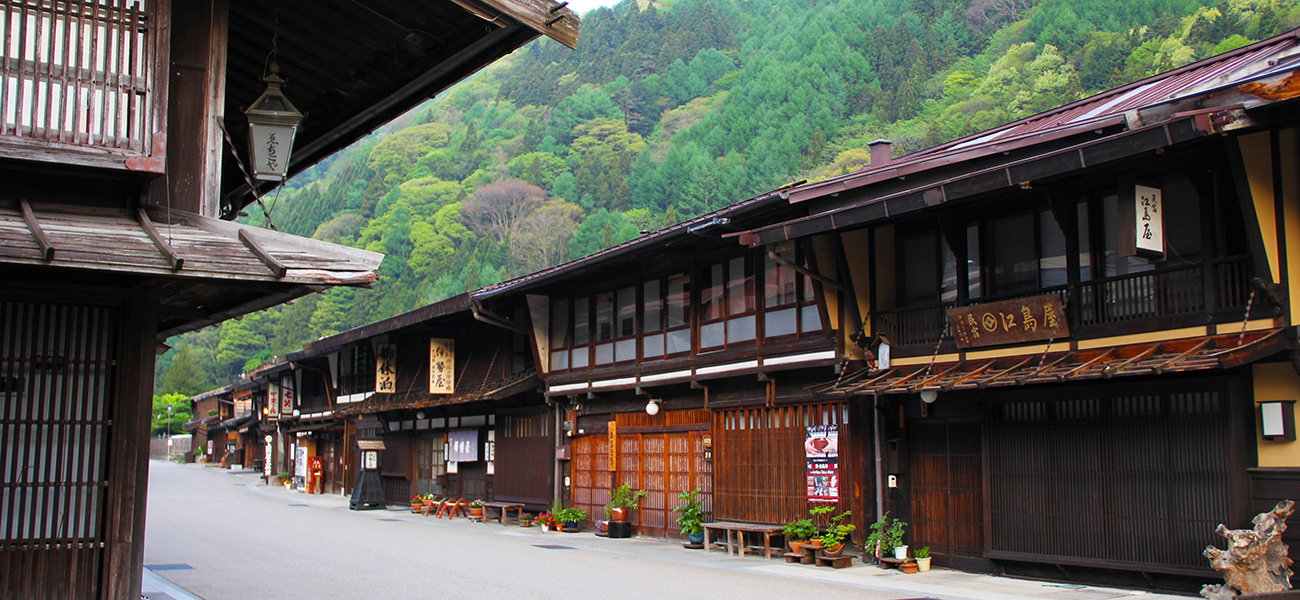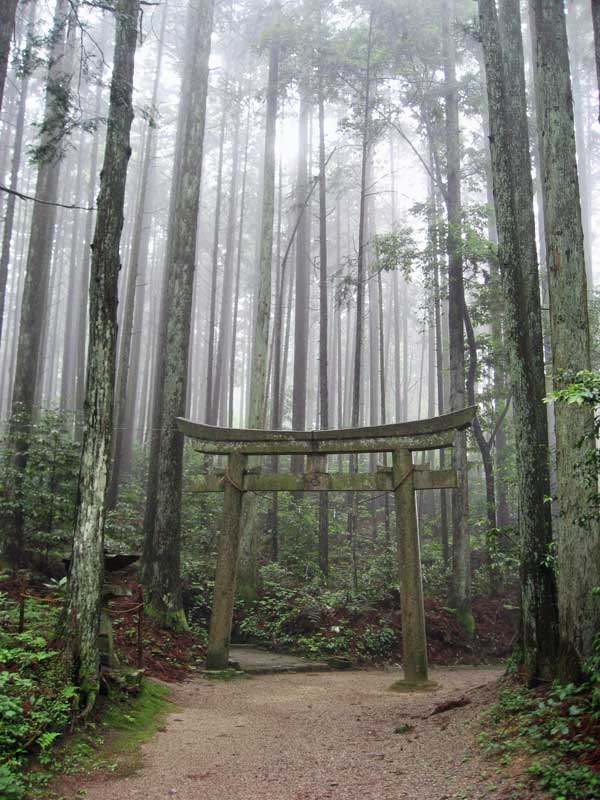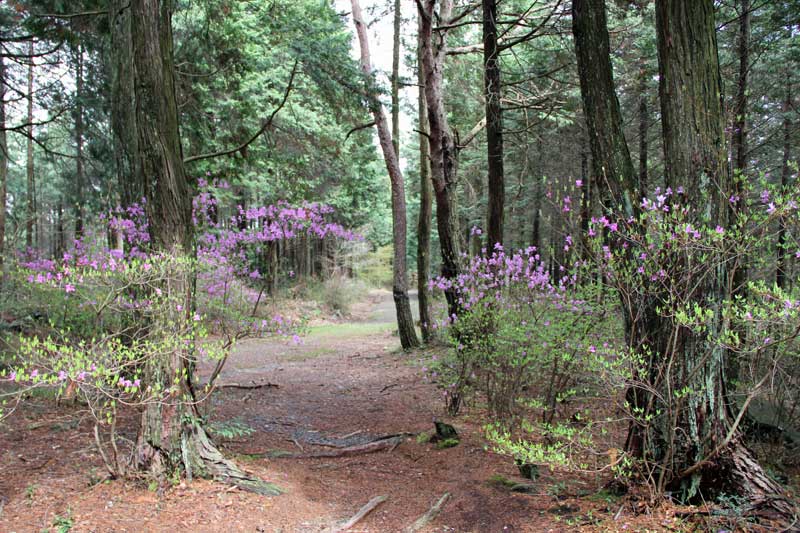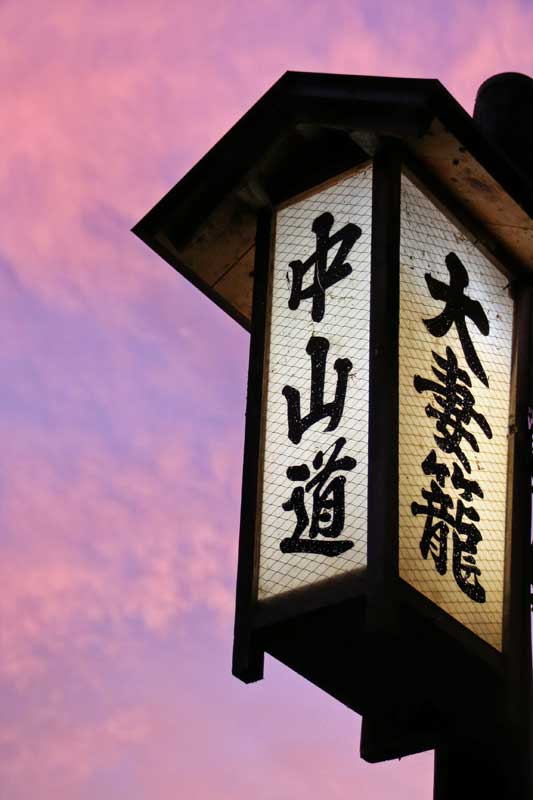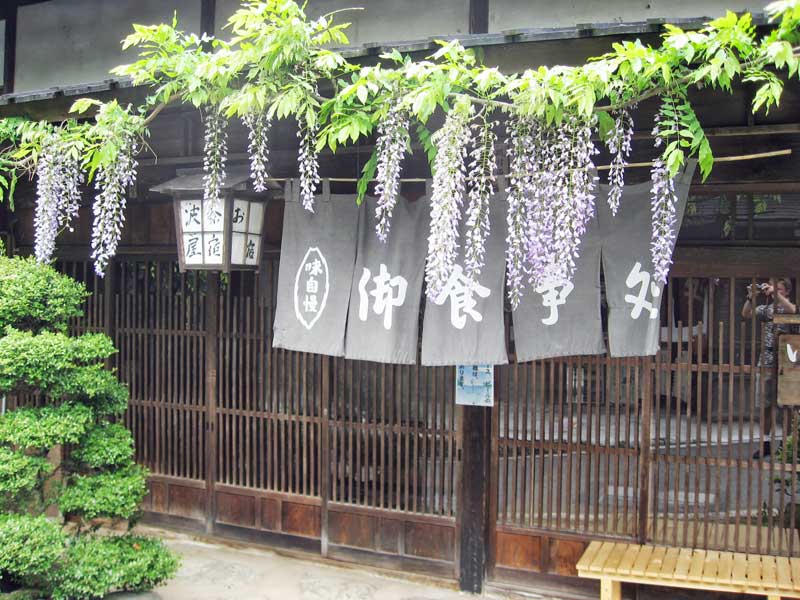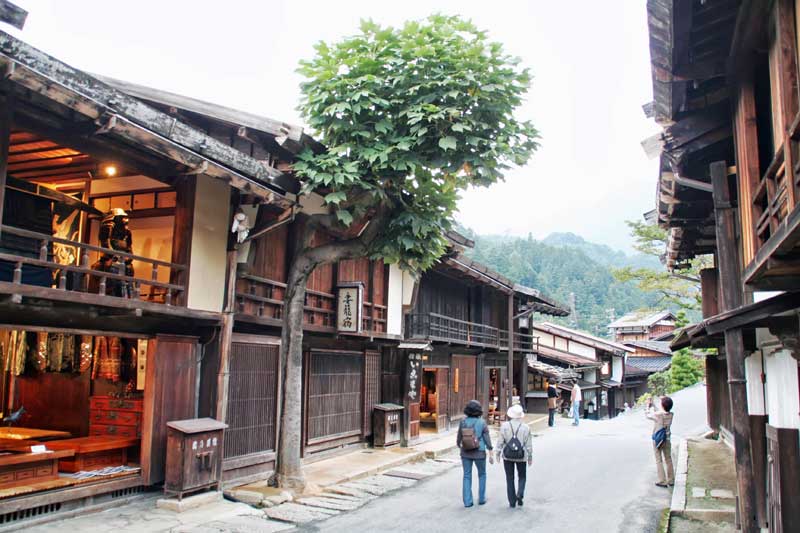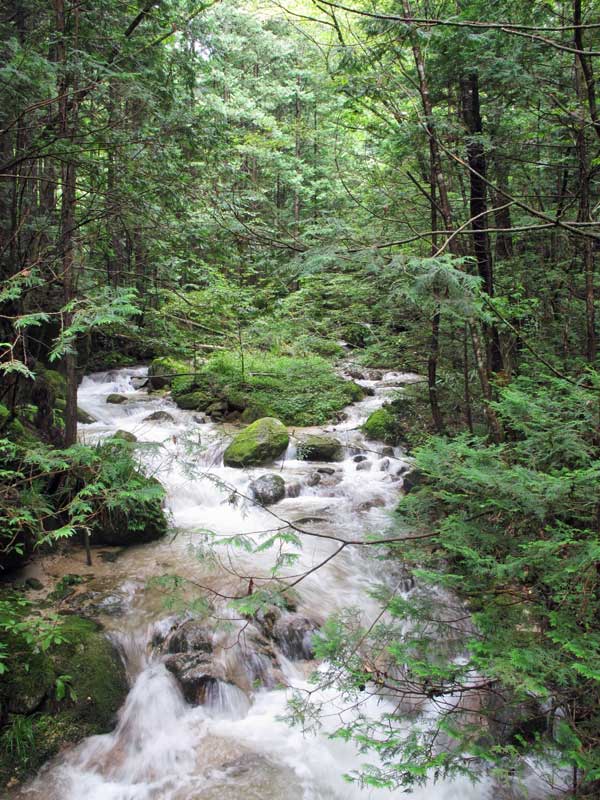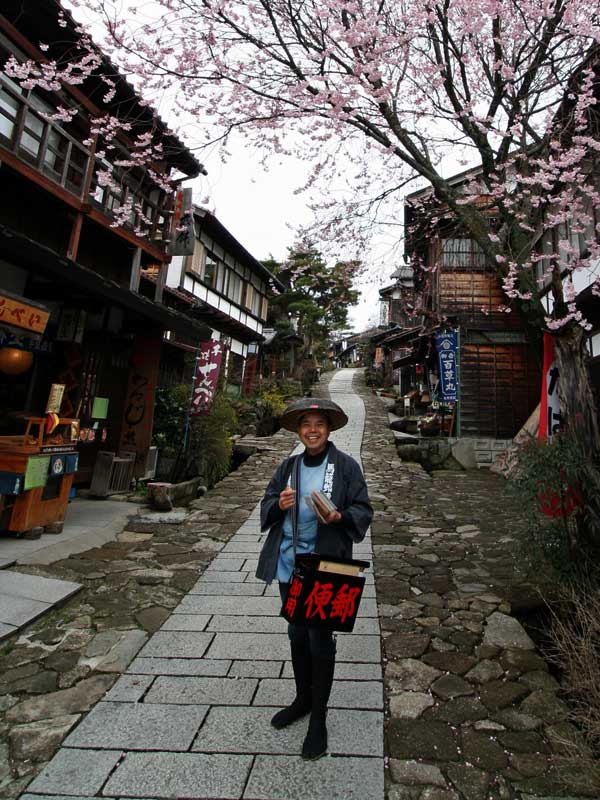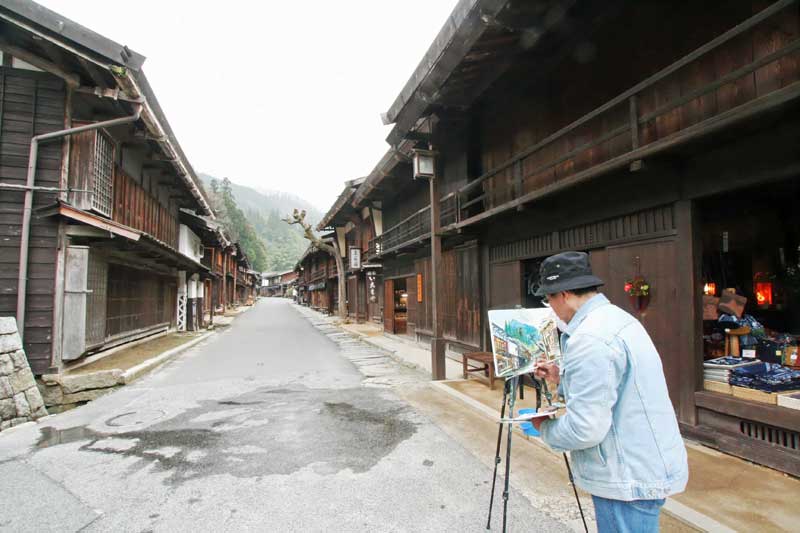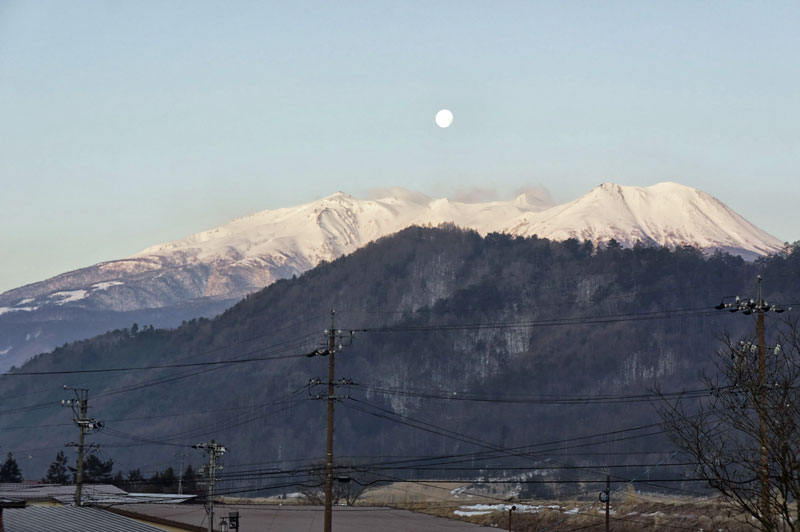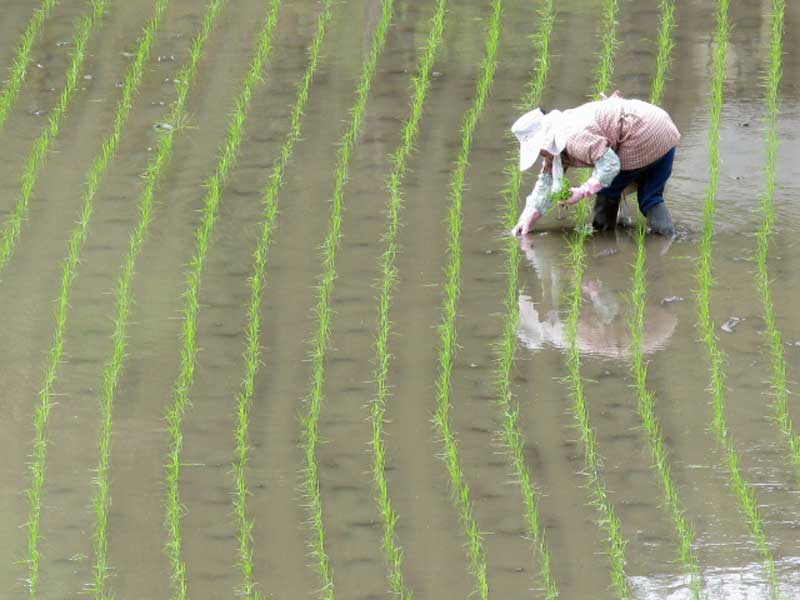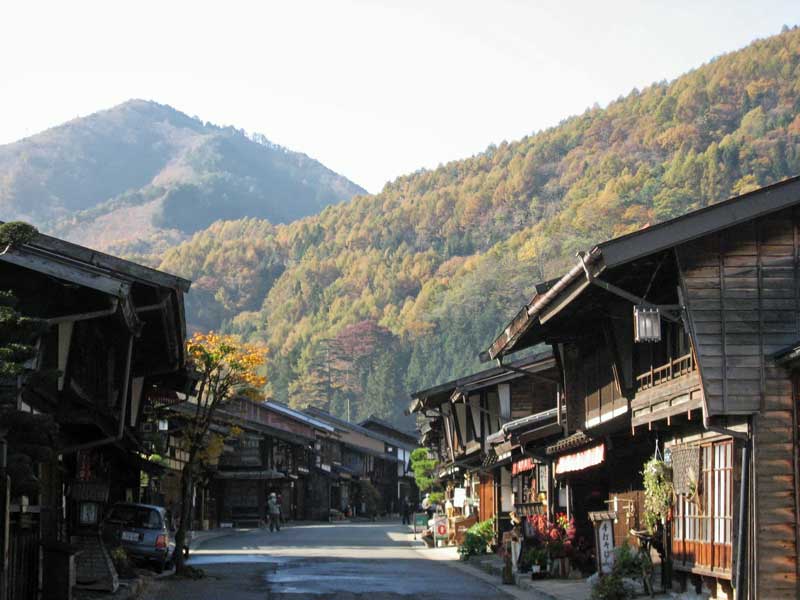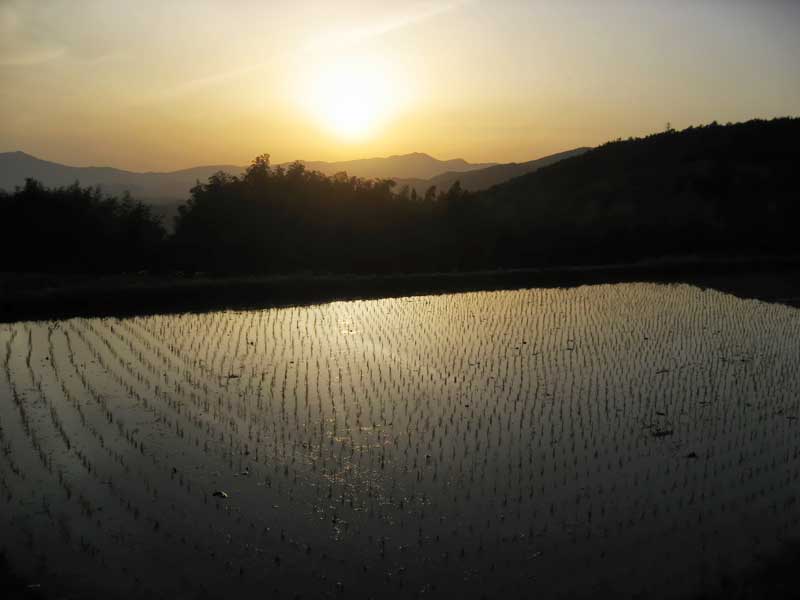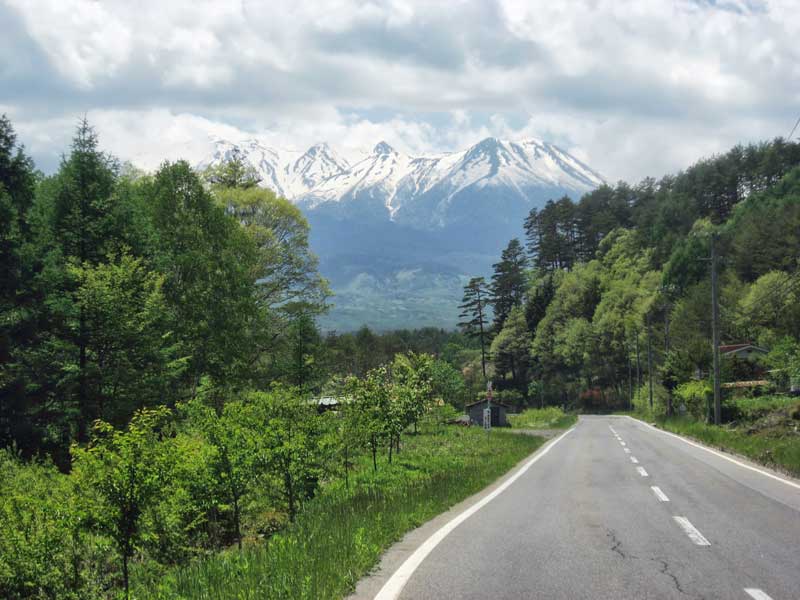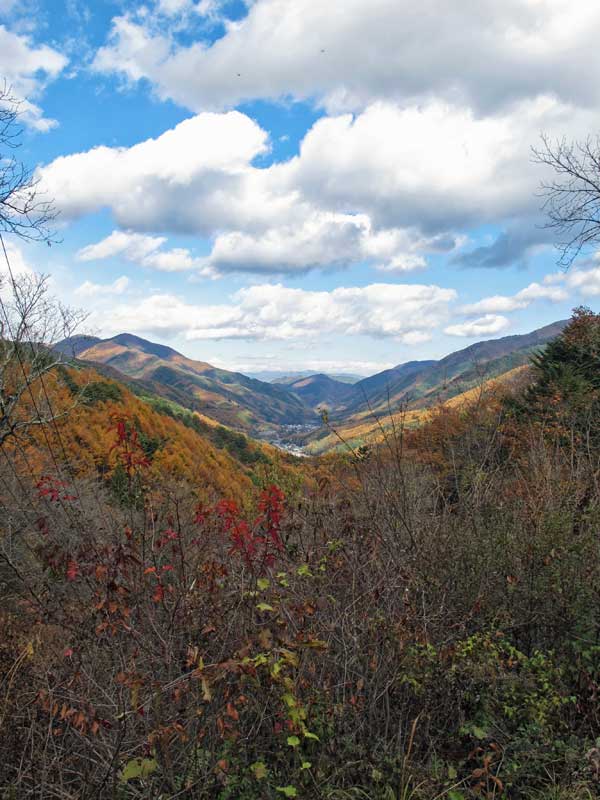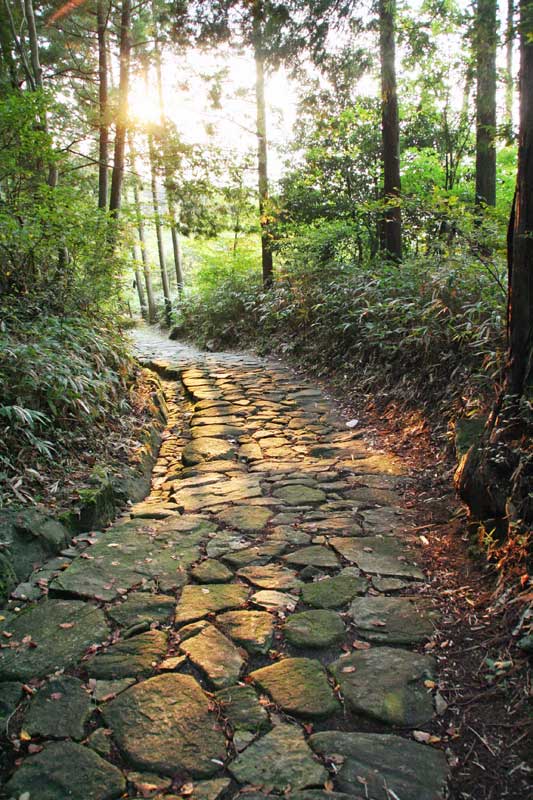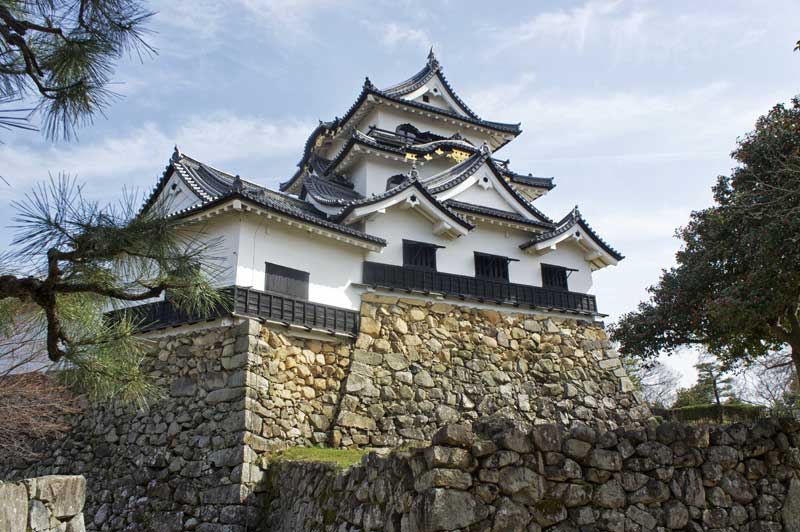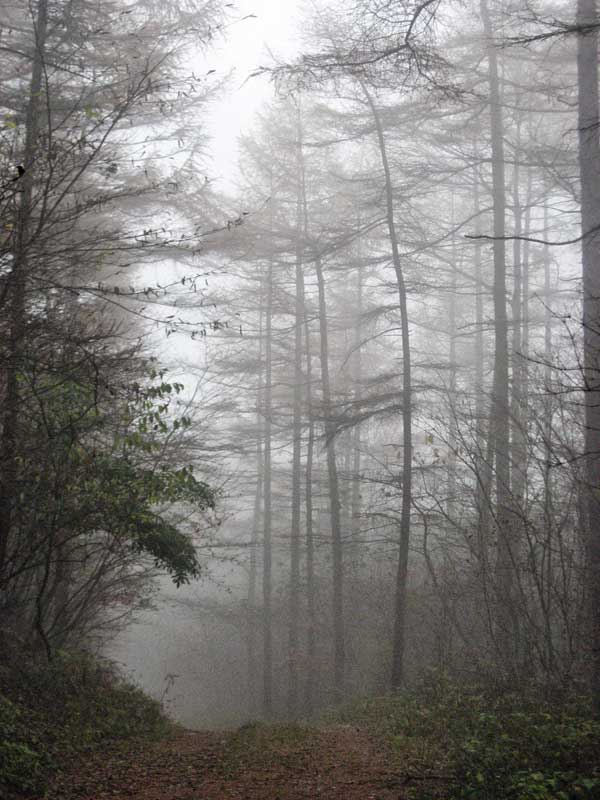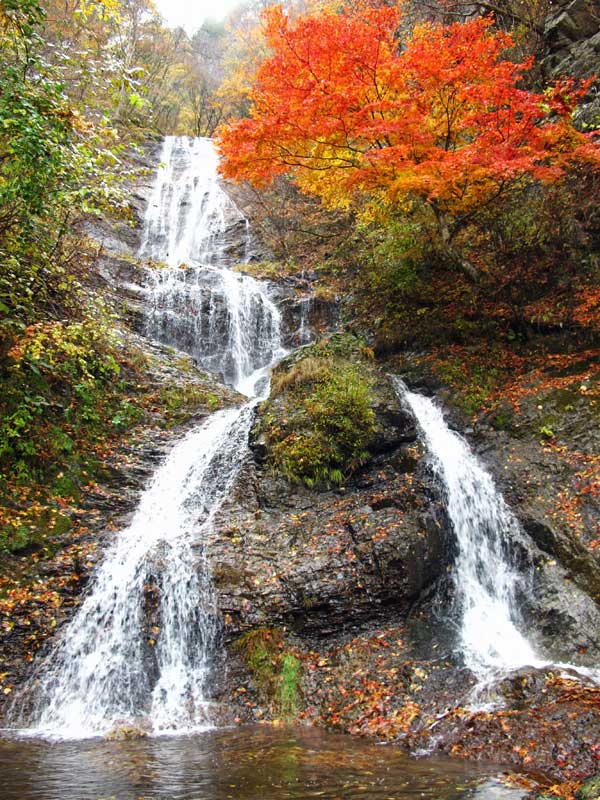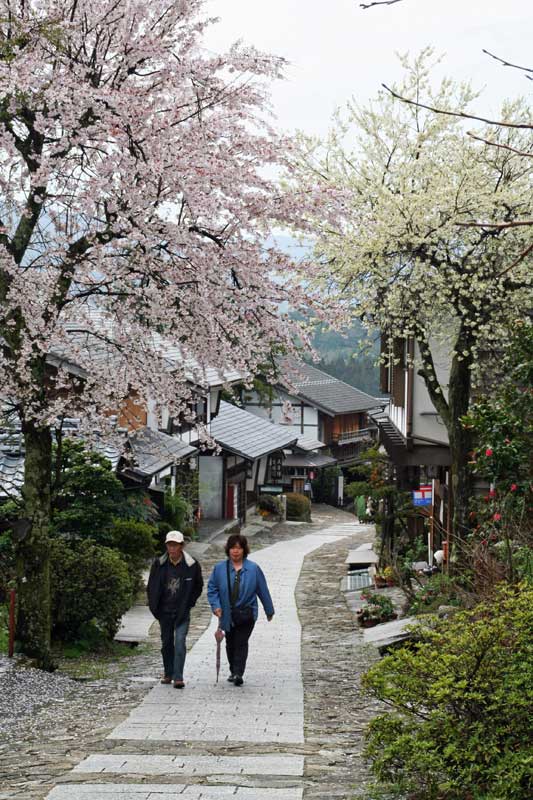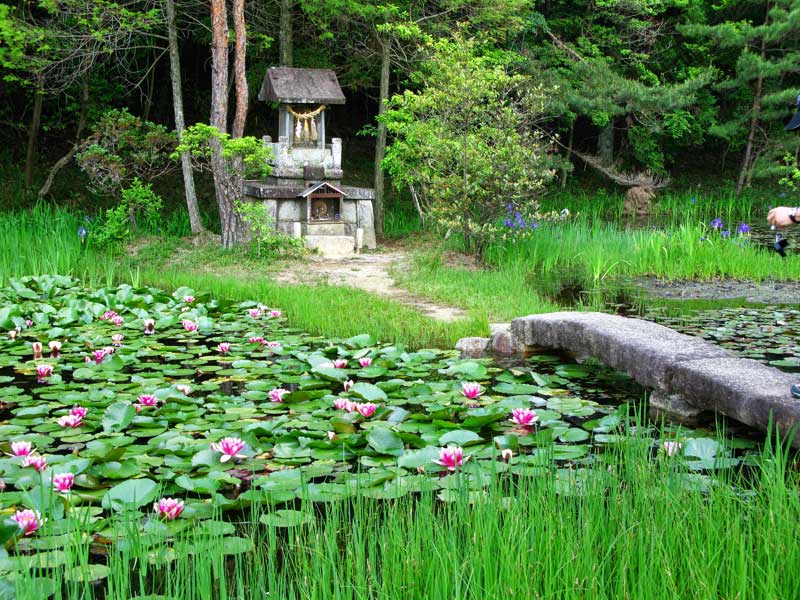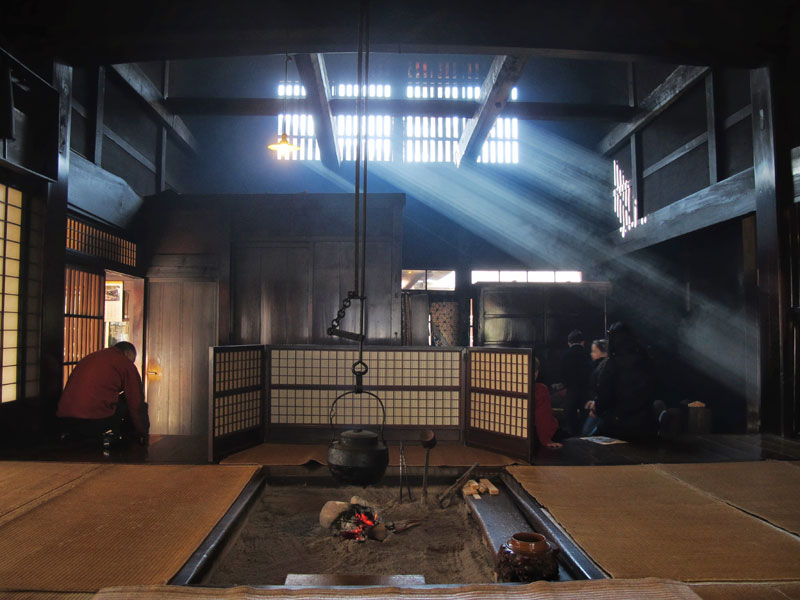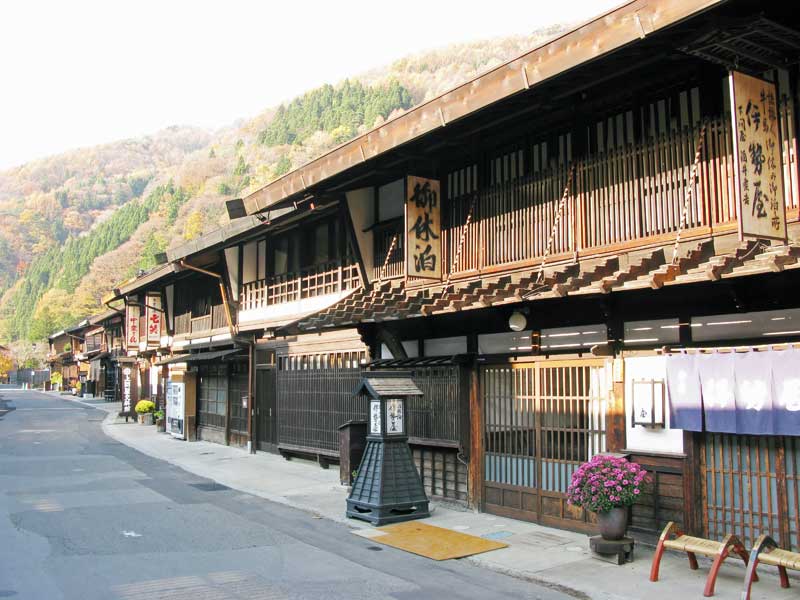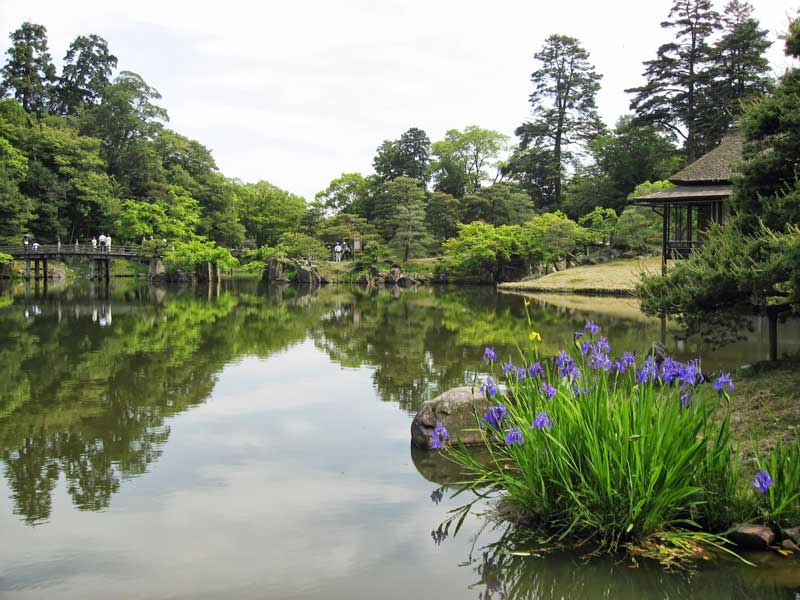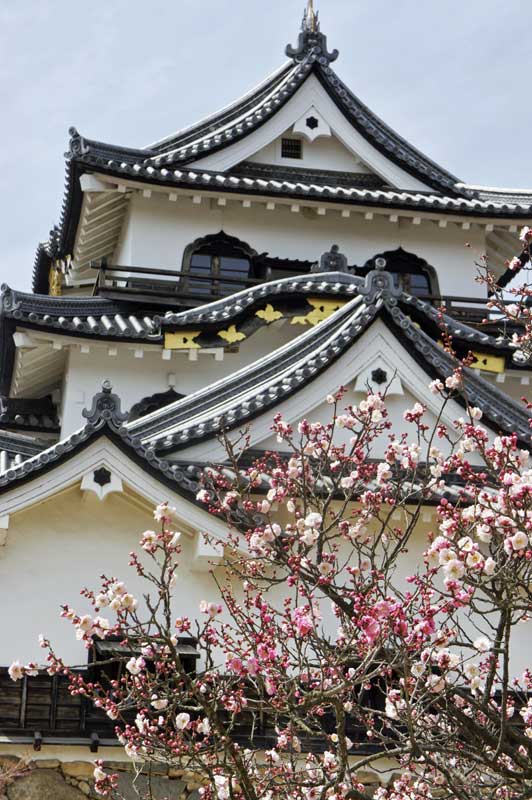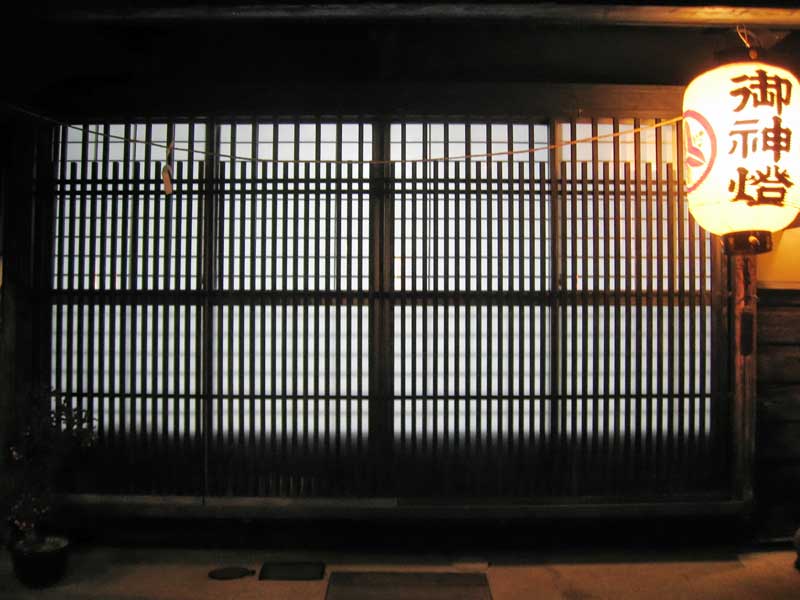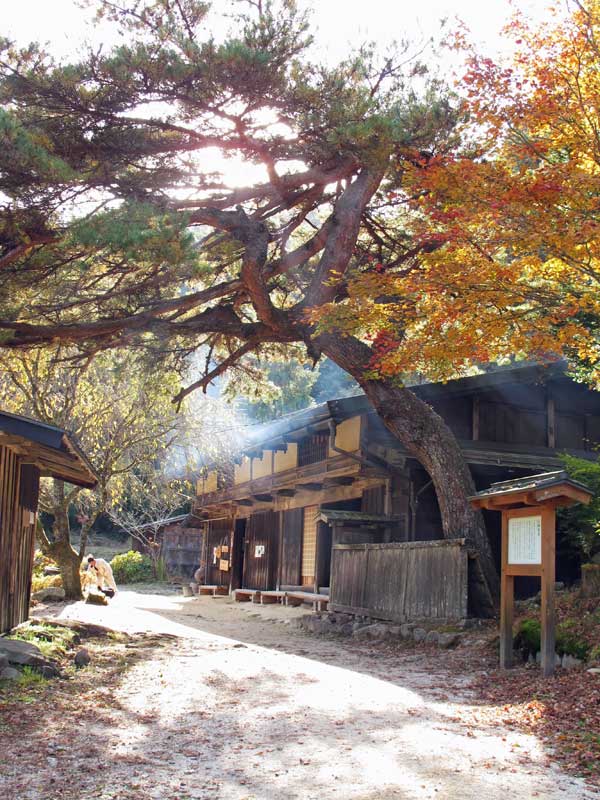A moderate walking tour along an ancient thoroughfare through central Japan.
Walk Japan's pioneering walking tour of Japan. An excellent guided introduction to Japan while strolling along an historical road from Kyoto to Tokyo; great walking and hiking through rural and mountainous countryside trails; traditional and modern inns, hearty farmhouse cuisine.
March - June & September - November.
An 11-day, 10-night tour starting in Kyoto and finishing in Tokyo. Tour accommodation is in hotels and Japanese inns. Please read more on accommodation here. The maximum group size for this tour is 12 persons. We have no minimum size. If we accept a booking we guarantee to run the tour.
The Nakasendo Way is a fully-guided walking tour between the Nakasendo's beginning in Kyoto and its end in Edo, modern-day Tokyo. Walk Japan's pioneering walking tour of Japan, the Nakasendo Way provides a unique, intimate experience of Japan and its people.
The Nakasendo Way tour explores one of Japan's ancient highways, the Nakasendo, which literally means 'the road through the mountains'. It starts in Kyoto, one of Japan’s ancient capitals and to this day the cultural epicentre of the nation, before following some of the best parts of the old road through rural countryside deep into the mountains of Japan’s Central Alps. Finally, we arrive in Tokyo, the glistening modern capital.
In its heyday in the seventeenth century, the Nakasendo was crowded with travellers, including feudal lords, samurai, itinerant merchants and pilgrims. Now largely forgotten and quiet, the road provides a pleasant trail through scenic countryside and also the history of Japan. We pass through and stay in picturesque old post towns en route in much the same way as Japanese travellers of old. Charming traditional inns, which have somehow survived into the modern world, provide us with friendly and atmospheric overnight accommodation. In the evenings, in an ambience reminiscent of Hiroshige's woodblock prints of feudal Japan, we relax and enjoy excellent meals.
The Nakasendo Way tour follows the most beautiful and enjoyable parts of the old highway. Travellers in the seventeenth century insisted on a reasonably easy route for their journey and so do we. This is a walking tour, not a trek. The average daily walking distance is a moderate 10–24km (6.2–16 miles). Transport can, however, be arranged for those who desire a more relaxed day. Our main baggage is sent on each morning so that we need only take what we need for the day in a small backpack. We climb several passes, but they have mostly gentle inclines and can be taken at a comfortable pace.
We meet in Kyoto and travel together through Hikone, Sekigahara, Magome, Tsumago, Narai and Karuizawa before finishing our journey at Nihonbashi in Tokyo. Walk Japan provides tour participants with easily followed, detailed instructions on how to join the tour.
More information about the history of the Nakasendo highway is available at our complementary website Nakasendo Way: A Journey to the Heart of Japan.
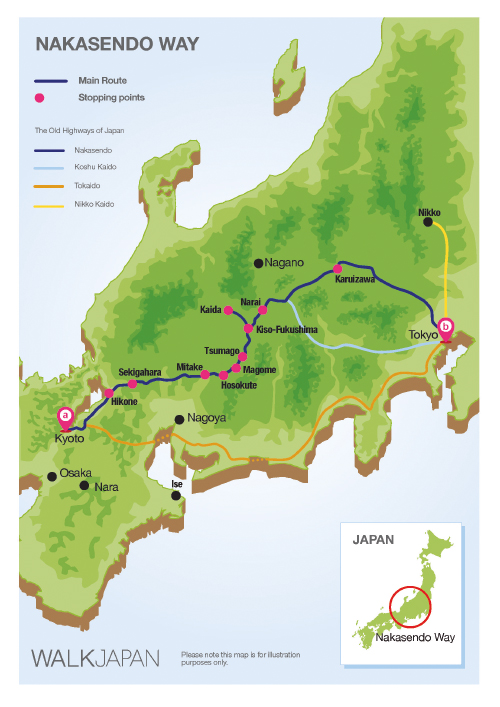
Please note that on Day 2 and Day 9 the main baggage will be shipped in advance overnight. On these days, you will need to carry all items you require overnight; your daypack should be sufficiently large to accommodate these items.
For those who wish to spend more time in Kyoto with Walk Japan, our Kyoto Tour is a fully-guided one-day city tour exploring Kyoto’s Higashiyama district. It starts at 8am and finishes at 4pm making it an ideal precursor for anyone joining our Nakasendo Way tour, which in turn starts at 6pm on the same day. Additionally, our fully-guided two-day Tokyo Tour starts after breakfast at the finish of the Nakasendo Way tour.
Day 1 Kyoto
The tour starts at 6pm in the tour hotel lobby, where your Tour Leader awaits to greet everybody and provide the tour briefing. Dinner follows at a hospitable local restaurant in a popular area of restaurants, bars and pubs. Here, on occasion, one or two of the famous geisha of the Gion district may be seen on their way to an appointment. En route, we visit the Sanjo-Ohashi, the bridge that marks the beginning of the Nakasendo Way, one of the five great highways of feudal Japan.
Accommodation: Western-style hotel.
Meals: Dinner provided.
Total walking: N/A.
Total elevation gain: N/A
Day 2 Kyoto – Hikone – Sekigahara
After breakfast we send our main baggage by overnight-courier to our inn on Day 3. Taxis transfer us to Kyoto Station, an impressive edifice, from where we depart by train on a line that loosely parallels the Nakasendo Way to Hikone, a castle town on the shores of Lake Biwa. This journey took two full days on foot; we cover the distance in just over an hour. We take a circuitous stroll through the town passing many historical features associated with Japan’s feudal highway system and castle towns before arriving at the castle itself. Once the home of the warrior Ii family, we learn about two members, separated by many generations, of the family who played fundamental roles in two major events in Japanese history; the battle of Sekigahara in 1600; and the opening of Japan to the Western trade in 1858. Surprisingly few foreign visitors find their way to Hikone despite its charm and the fact that the castle is one of only a few listed as a Japanese National Treasure. Many period films have been shot here including Shogun, which stared Richard Chamberlain and Toshiro Mifune.
We continue our journey by train to Sekigahara, the site in 1600 of one of the most important battles in Japanese history. It ended a century of civil wars and heralded the start of the Edo Period (1603–1868) dominated by the victorious Tokugawa family. Our inn tonight is in the centre of town aside the Nakasendo Way that has a history of providing accommodation stretching back over 1,000 years. In its traditional environment we spend the first of many nights on this tour in a very Japanese style.
Accommodation: Traditional Japanese inn.
Meals: Breakfast & dinner provided.
Total walking: 8km (5 miles).
Total elevation gain: 89m (290ft).
Day 3 Sekigahara – Mitake – Hosokute
A series of trains, each smaller and more rustic than the one before, takes us to the end of the line at Mitake, a quiet post-town. Here we begin our walk in earnest on the old highway. Our route meanders past rice paddies and through quiet villages and wooded hills. Clues that we are on the Nakasendo Way are all around. Occasional stretches of the path still retain the original stone paving laid to assist on tricky uphill climbs, and wayside shrines and deities abound for the protection of the foot-weary and in remembrance for the souls of pack horses, which had succumbed under their burdens. Signs indicate the sites of former tea-houses where travellers of old would stop awhile to rest, quench their thirst and fill their stomachs. Although none remain today a very pleasant tea and cake shop, popular with passers-by and locals alike, is the modern-day equivalent.
We approach Hosokute, once one of the smallest post towns on the Nakasendo Way, before transferring to our nearby accommodation for bathing and dinner, a feast of local produce.
Accommodation: Traditional Japanese inn with onsen hot spring baths.
Meals: Breakfast, lunch & dinner provided.
Total walking: 12km (7.4 miles).
Total elevation gain: 465m (1,525ft).
Day 4 Hosokute – Ena
After enjoying breakfast in our inn, we begin the second longest walk of this tour to Ena that includes a ridge-top route dating from the 8th Century. After strolling along quiet country roads, we begin a gentle ascent through forest to a pass on a section of the Nakasendo Way that had lain forgotten for decades. The climb and descent incorporates one of the longest continuous stretch of original ishidatami stone paving in Japan. At the summit a stone inscription records the poignant poem composed here by Kazunomiya, an imperial princess who was forced against her will to leave the Imperial court in Kyoto to become the shogun’s wife and live in Edo. She was the last of many imperial princesses who travelled this highway to marry into the shogun’s family and along the highway there are several memorials to her journey. Because of this locals sometimes refer to the Nakasendo Way as the Princess’ highway.
We descend to Okute, another old post town and now a delightful hamlet. At the entrance to the town we encounter a giant cedar tree that is believed to be 1,300 years old and venerated as a kami Shinto deity. Okute, which still retains a flavour of its 19th Century character, always has a delightful peaceful repose.
For much of our afternoon walk, the old highway follows a trail through forest. This section, known as the Jusan-toge, which translates as the Thirteen Passes, is actually an easily negotiated undulating route along ridge tops that offer many fine views of the distant mountains. This section of the highway dates back to the seventh century, when the valleys on either side remained uncultivated and virtually impassable. We emerge from the forests to the roar of traffic on the modern expressway, which marks our arrival in Ena.
Here we visit a museum dedicated to Hiroshige, one of Japan’s two great wood-block print artists, before retiring to our accommodation, a comfortable business hotel. Our rooms have ensuite facilities and a coin laundry is also available. Tonight we venture out into town for dinner at a local restaurant.
Accommodation: Western-style hotel.
Meals: Breakfast, lunch & dinner provided.
Total walking: 22km (13.6 miles).
Total elevation gain: 346m (1,135ft).
Day 5 Ena – Magome
Our morning’s walk takes us across gently undulating rural countryside to Nakatsugawa, an old post town and now a pleasant regional centre where we enjoy lunch. In the afternoon, we begin in similar fashion to that of the morning, except that the general direction of our route is distinctly uphill. We now embark on the climb that tomorrow takes us over Magome Pass, which leads to the Kiso Valley and the heart of the Nakasendo Way. We are afforded some superb views across the surrounding countryside before arriving at Ochiai, another post-town that still retains its honjin, the top-class inns used by the Edo elite. Although it no longer functions as an inn, it is open for the public to take a peek.
A final climb over ishidatami stone paving brings us to tonight’s inn set aside the highway in a very photogenic location. Our hosts always welcome us very amiably and provide us with a sumptuous evening meal they have created from ingredients they have either grown or caught in the surrounding fields and forests.
Accommodation: Traditional Japanese inn
Meals: Breakfast & dinner provided.
Total walking: 18km (11 miles).
Total elevation gain: 425m (1,394ft).
Day 6 Magome – Tsumago
Our hosts wave us off in unison as we begin the short walk that brings us to Magome, a famed post town and birth-place of author Shimazaki Toson. His novel Before the Dawn describes life during the tumultuous period following Japan’s opening to the West in the 1860s and 1870s. Magome is touristy but is well-worth our time to spend awhile exploring.
Leaving the town, we continue on our way up to Magome Pass. From here on, our surroundings change from open countryside to the thickly forested deep Kiso Valley. We take a respite at a traditional teahouse continuing on via a pair of waterfalls to our next inn in the small hamlet of O-tsumago. We drop off any unnecessary luggage here before venturing to the village of Tsumago, which is a little further beyond.
Tsumago is the best preserved and arguably the most attractive post town found anywhere in Japan. The inhabitants take great pride in their town, and have banished telephone poles, electric lines and vending machines from the main street. Following a guided tour of a former waki-honjin high class inn, once reserved only for senior samurai retainers, we return to our inn for an evening bath before dinner. A feature of the latter is ayu, a freshwater fish common in the region. Our morsel was reared in O-tsumago’s communal small fish farm, which we passed on our way earlier.
Accommodation: Traditional Japanese inn.
Meals: Breakfast, lunch & dinner provided.
Total walking: 10km (6.2 miles).
Total elevation gain: 461m (1,512ft).
Day 7 Tsumago – Kiso-Fukushima
Today we undertake the longest walk of the tour. We follow the old highway back to Tsumago and on to Nagiso through picturesque hamlets and aside paddy fields. Entering Nagiso, in the distance we catch a glimpse of Momosuke-bashi, an impressive wooden suspension bridge that traverses the Kiso River. The bridge was built in 1922 by Momosuke Fukuzawa, an industrialist whose partner was the ex-geisha Sadayakko, a colourful character who electrified the west at the turn of the 20th Century
We now start one of the alternative routes of the old highway through this area, avoiding the easier riverside way, which is now overlaid by a busy modern road. Instead, we take the original route of the Nakasendo Way. Over three to four hours, it gradually takes us higher and higher through quiet farming hamlets until a final ascent through a forest to Ne-no-Ue Pass. At many points along our climb, we see the remains of the extensive narrow-gauge logging railway system that reached far into the mountains of the Kiso Valley in the early 20th century.
From the pass, it is a steep, hour-long descent to Nojiri, from where a 40-minute rail journey takes us to Kiso-Fukushima, that has been the principal town in the valley since the Edo Period. Our centrally located, traditional inn has a welcome attraction: its own onsen hot spring baths to relax in before dinner, which is yet another multi-course meal.
For those who do not wish to walk the full distance today, onward travel can be made by train from Nagiso to Kiso-Fukushima.
Accommodation: Traditional Japanese inn with onsen hot spring baths.
Meals: Breakfast & dinner provided.
Total walking: 24km (14.9 miles).
Total elevation gain: 714m (2,340ft).
Day 8 Kiso-Fukushima – Kaida Plateau
After breakfast in our inn, we first visit the town’s reconstructed barrier station that straddles the old highway. Here, samurai guards once checked each and every person for their authorisation to travel and for any banned transport of weapons. For the rest of the day, we leave the Nakasendo Way for a visit to Kaida Kogen, a beautiful plateau. We transfer by private vehicle to Karasawa-no-taki, a spectacular 100 metre high waterfall, from where we start our walk on the Hida Kaido, a spur to the Nakasendo Way, through forests over the Jizo Pass and down to the plateau. The plateau is dominated by Mt. Ontake-san, an active volcano that is considered sacred by an esoteric Buddhist sect.
After lunch, our afternoon’s excursion continues on the spur road and takes us over another high pass. Here an optional short but stiff climb brings us to the site of an ancient castle from where, on a clear day, wonderful views are afforded over Kaida Kogen to Mt. Ontake. At 1,422m, it is also the highest point we reach on this tour. The descent from here leads us to our accommodation: another delightful, traditional Japanese inn with onsen hot spring baths.
Please note that depending on weather conditions tours from January through to mid-March tours, we may experience snow on a higher pass today and another on Day 9. In these circumstances we use snowshoes to make our way.
Accommodation:Traditional Japanese inn with onsen hot spring baths.
Meals: Breakfast, lunch & dinner provided.
Total walking: 14km (8.7 miles).
Total elevation gain: 673m (2,200ft).
Day 9 Kaida Plateau – Narai – Karuizawa
We send our main luggage off by overnight courier to Tokyo before transfering by private vehicle to Yabuhara, from where we walk eight kilometres through forests up to and over the Torii Pass to Narai, another lovely, picturesque post town. Here we enjoy lunch and have time to explore this elegant small town. Early afternoon we set off on a series of trains, including a Shinkansen bullet train, for Karuizawa, where we stay the night.
Once a post town on the Nakasendo Way, Karuizawa is now the epitome of a high-class Japanese mountain resort town. 18th Century Christian missionaries first found a cool and comfortable escape here in summer from the humidity and heat of the lowlands. Today, Karuizawa is known as a retreat for wealthy Tokyoites and as a popular destination for day visitors. Famously, John Lennon frequented the town with Yoko Ono. We stay in a top-class, historic inn that has deep associations with some of the nation’s greatest literary figures, including Tanizaki Junichiro and Akutagawa Ryunosuke.
The duration and destination of our walk will depend on weather conditions. For tours in January through March there may be a chance to snowshoe, again dependent on weather conditions.
Accommodation: Traditional Japanese inn with onsen hot spring baths.
Meals: Breakfast, lunch & dinner provided.
Total walking: 11km (6.8 miles).
Total elevation gain: 373m (1,220ft).
Day 10 Karuizawa – Tokyo
We step out of our inn onto the Nakasendo Way and soon are following a path up through lush maple forests to the Usui Pass. At the top we enjoy spectacular views across the surrounding countryside to Asama-yama, an active volcano.
A long descent follows on a footpath through mixed forest. Nearing the end a dramatic view opens up across a valley to the next post town of Sakamoto. The final section of the walk is along a disused track-bed of a rack-and-pinion railway that once connected the Kanto plain surrounding Tokyo with the highlands of Karuizawa and beyond. It was replaced in 1997 by Shinkansen bullet trains, which speed out of sight in tunnels bored through nearby mountains. From here we travel first by a local and then a bullet train to Tokyo, where we arrive late afternoon.
We complete our walk over the last kilometre of the Nakasendo Way to Nihonbashi and the famous bridge after which the district is named. This bridge is where the old highway terminated and it makes a fitting site to complete our journey. Our hotel is nearby in central Tokyo and we enjoy a delicious final dinner together at a local restaurant.
Accommodation: Western-style hotel.
Meals: Breakfast & dinner provided.
Total walking: 16km (10 miles).
Total elevation gain: 438m (1,440ft).
Day 11 Tokyo
The tour ends after breakfast and your Tour Leader will be on hand to advise on how to purchase train tickets for onward journeys within Japan or to your departure airport. Please do not hesitate to make your travel requirements known during the tour.
Accommodation: N/A.
Meals: Breakfast provided.
Total walking: N/A.
Total elevation gain: N/A.
This itinerary is subject to change.
For more information about the history of the Nakasendo highway is available at our complementary website Nakasendo Way: A Journey to the Heart of Japan.
The airport closest to the tour's start at Kyoto is Osaka’s Kansai International Airport. Transfer is also easily made from both Tokyo’s Narita and Haneda International Airports.
-----
FROM OSAKA’S KANSAI INTERNATIONAL AIRPORT (KIX)
From Osaka’s Kansai International Airport, Haruka Express trains depart to Kyoto Station, where the train terminates. The journey costs about JPY3,290 per person and takes approximately 1 hour 15 minutes. From here, take a taxi to the accommodation.
-----
FROM TOKYO’S HANEDA AIRPORT (HND)
From Tokyo’s Haneda International Airport, Keikyu Line trains depart to Shinagawa Station, where shinkansen bullet trains then depart for Kyoto. The journey costs about JPY13,900 per person and takes approximately 3 hours 10 minutes. From here, take a taxi to the accommodation.
-----
FROM TOKYO’S NARITA AIRPORT (NRT)
From Tokyo’s Narita International Airport, Narita Express trains depart to Tokyo Station, where shinkansen bullet trains then depart for Kyoto. The journey costs about JPY16,240 per person and takes approximately 3 hours 30 minutes. From here, take a taxi to the accommodation.
-----
The pre-tour pack includes detailed instructions, including a map, for travel to the accommodation at the start of the tour.
Tour participants are advised not to book themselves out on an early morning flight at the end of the tour from Narita International Airport or Kansai International Airport. Haneda Airport, however, is a 30 minute journey away by taxi and easily reached at any time of the day.

